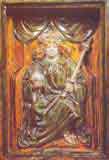|
The principal settlement in early mediaeval times was Óbuda (the name means "old Buda") to the north of the inner city. But the Mongol invasion of 1241 prompted King Béla IV to move his court from the relative vulnerability of the flat Danube floodplain, up to Castle Hill . Buda and Pest were two completely separate towns, with Pest the site of trade and business while Buda was occasional home to the court and the treasury. During the early mediaeval period the court was semi-nomadic, moving around Transdanubia (the lands to the west of the Danube), and was not permanently based at Buda. By the 15th century, however, the Renaissance King Mátyás (Matthias Corvinus, 1443-1490) was so wealthy that he held court both at Visegrad, on the Danube Bend north of the city, and in Buda. . Buda and Pest were two completely separate towns, with Pest the site of trade and business while Buda was occasional home to the court and the treasury. During the early mediaeval period the court was semi-nomadic, moving around Transdanubia (the lands to the west of the Danube), and was not permanently based at Buda. By the 15th century, however, the Renaissance King Mátyás (Matthias Corvinus, 1443-1490) was so wealthy that he held court both at Visegrad, on the Danube Bend north of the city, and in Buda. |
Mátyas was celebrated as a paragon of cultured humanism. His palace at Buda is said to have rivalled anything in Europe for opulence and beauty, and visitors gasped at all the cloth of gold they saw, as well as at the  ornamental gardens, fountains and statuary. Besides being home to every pleasure and luxury, the Hungarian court was also a centre of great learning. The famous Biblioteca Corviniana, which Mátyas founded, was kept on Castle Hill, and many scholars from all over Europe gathered in Buda as a result. ornamental gardens, fountains and statuary. Besides being home to every pleasure and luxury, the Hungarian court was also a centre of great learning. The famous Biblioteca Corviniana, which Mátyas founded, was kept on Castle Hill, and many scholars from all over Europe gathered in Buda as a result.
|
|
|